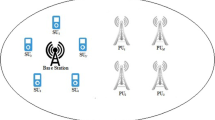Abstract
In this paper, an enhanced cooperative, statistics-driven spectrum sensing algorithm, called Dynamically Optimized Spatiotemporal Prioritization (DOSP), is developed for improving spectrum sensing efficiency in the media access control (MAC) layer of cognitive radio (CR) systems. The target of the DOSP algorithm is to improve spectrum sensing efficiency and achieve better spectrum access opportunities by prioritizing channels for fine sensing. The sensing priority is determined dynamically and intelligently based on an optimal statistical fusion that jointly considers both the local statistics obtained by the individual cognitive radios as well as the long-term spatiotemporal statistics obtained by other cognitive radios in the network. As such, the individual cognitive radio peers work together to get the most out of available spectrum opportunities. Numerical results demonstrate that the proposed DOSP algorithm is capable of achieving better performance compared with recently reported cooperative spectrum sensing methods in terms of overhead and percentage of missed spectrum opportunities. Furthermore, results show that the DOSP algorithm is more robust to the environment of low cognitive radio densities than that by using other state-of-the-art cooperative spectrum sensing methods.







Similar content being viewed by others
References
Miltola, J. (1999). Cognitive radio: Making software radios more personal. IEEE Personal Communications, 6(4), 13–18.
Haykin, S. (2005). Cognitive radio: Brain-empowered wireless communication. IEEE Journal on Selected Area in Communications, 23(2), 201–220.
Ghasemi, A., & Sousa, E. S. (2008). Spectrum sensing in cognitive radio networks: Requriements, challenges and design tradeoffs. IEEE Communication Magazine, 46, 32–39.
Lee, K., & Yener, A. (2007). Throughput enhancing cooperative spectrum sensing strategies for cognitive radios. In Proc. IEEE ACSSC, pp. 2045–2049.
Sun, C., Zhang, W., & Letaief, K. B. (2007). Cooperative spectrum sensing for cognitive radios under bandwidth constraints. In Proc. IEEE WCNC, pp. 1–5.
Chen, L., Wang, J., & Li, S. (2007). An adaptive cooperative spectrum sensing scheme based on the optimal data fusion rule. In Proc. IEEE ISWCS, pp. 582–586.
Ghasemi, A., & Sousa, E. S. (2006). Collaborative spectrum sensing for opportunistic access in fading environments. In Proc. IEEE DYSPAN, pp. 131–136.
Lee, C., & Wolf, W. (2008). Energy efficient technique for cooperative spectrum sensing in cognitive radios. In Proc. IEEE CCNC, pp. 968–972.
Lee, C., & Wolf, W. (2007). Multiple access-inspired cooperative spectrum sensing for cognitive radio. In Proc. IEEE MILCOM, pp. 1–6.
Ganesan, G., Li, Y., Bing, B., & Li, S. (2008). Spatiotemporal sensing in cognivire radio networks. IEEE Journal on Selected Area in Communications, 26(1), 5–13.
Ganesan, G., & Li, Y. (2007). Cooperative spectrum sensning in cognitive radio, part i: Two user networks. IEEE Transactions on Wireless Communications, 6(6), 2204–2213.
Zhang, W., Mallik, R. K., & Letaief, K. B. (2008). Cooperative spectrum sensing optimization in cognitive radio networks. In Proc. ICC, pp. 262–266.
Gandetto, M., & Regazzoni, C. (2007). Spectrum sensing: A distributed approach for cognitive terminals. IEEE Journal on Selected Area in Communication, 25(3), 546–558.
Quan, Z., Cui, S., & Sayed, A. H. (2007). An optimal strategy for cooperative spectrum sensing in cognitive radio networks. In Proc. IEEE GLOBECOM, pp. 2947–2951.
Ma, J., & Li, Y. (2007). Soft combination and detection for cooperative spectrum sensing in cognitive radio networks. In Proc. IEEE GLOBECOM, pp. 3139–3143.
Wang, X. Y., Wong, A., & Ho, P.-H. (2009). Stochastic channel prioritization for spectrum sensing in cooperative cognitive radio. accepted to IEEE CCNC.
Geirhofer, S., Tong, L., & Sadler, B. (2007). Cognitive radios for dynamic spectrum access—dynamic spectrum access in the time domain: Modeling and exploiting white space. IEEE Communications Magazine, 45(5), 66–72.
Mangold, S., Zhong, Z., Challapali, K., & Chou, C. (2004). Spectrum agile radio: Radio resource measurements for opportunistic spectrum usage. Proc. GLOBECOM, 6, pp. 3467–3471.
IEEE 802.221.22TM/D0.1. (2006). Draft standard for wireless regional area networks part 22: Cognitive wireless RAN medium access control (MAC) and physical layer (PHY) specifications: Policies and procedures for operation in the TV bands.
Digham, F. F., Alouini, M.-S., & Simon, M. K. (2007). On the energy detection of unknown signals over fading channels. IEEE Trans. on Communication, 55, 21–24.
Gardner, W. A. (1994). Cyclostationarity in communications and signal processing. IEEE Press.
Wang, X. Y., Ho, P.-H., & Wong, A. (2008). Towards efficient spectrum sensing for cognitive radio through knowledge-based reasoning. IEEE DySPAN.
Silverman, B. W. (1986). Density estimation. London: Chapman and Hall.
Boggs, P., & Tolle, J. (1995). Sequential quadratic programming. Acta Numerica, 151.
Acknowledgments
This study is conducted under the “Wireless Broadband Communications Technology and Application Project” of the Institute for Information Industry which is subsidized by the Ministry of Economy Affairs of the Republic of China.This research has been partially sponsored by the Natural Sciences and Engineering Research Council of Canada.
Author information
Authors and Affiliations
Corresponding author
Rights and permissions
About this article
Cite this article
Wang, X.Y., Wong, A. & Ho, PH. Dynamically optimized spatiotemporal prioritization for spectrum sensing in cooperative cognitive radio. Wireless Netw 16, 889–901 (2010). https://doi.org/10.1007/s11276-009-0175-0
Published:
Issue Date:
DOI: https://doi.org/10.1007/s11276-009-0175-0




